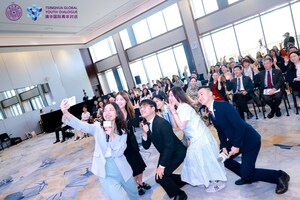"Interwoven Perspectives": 2020 China and USA Technology & Innovation in Fiber Art Virtual Exhibition Opens Online
BEIJING, Nov. 23, 2020 /PRNewswire/ -- The 2020 China and USA Technology & Innovation in Fiber Art Virtual Exhibition, jointly hosted by the Tsinghua University Academy of Arts & Design (Beijing, China) and the University of the Arts (Philadelphia, USA), opens virtually on Nov. 23, 2020 at https://fibertechart.ad.tsinghua.edu.cn and will be on display through Dec. 24. The international online forum with be held on Dec. 5, 9:00 AM, China Standard Time over VooV Meeting (a.k.a. Tencent Meeting).
Jointly curated by Yue Song of Tsinghua and Mi-Kyoung Lee of UArts, the exhibition features 40 installations that represent the latest technological breakthroughs in fiber art, the work of 47 Chinese and US artists from a wide variety of backgrounds and research interests. The exhibition and forum delve deep into the intersection of fiber art and technology in an everchanging technological landscape. They highlight works that employ new technologies or materials, explore how innovative technology and traditional craft revolutionize our creative methods, and look ahead to the future development of fiber art.
The Chinese and US artists and scientists' explorations of fiber arts, new materials, and new technologies include Lin Lecheng's woven-bamboo installation, a collaboration with a computer programmer; Yue Song, Ren Guanghui, and Tao Xiaoming's works which integrated optical fiber; and Yang Jing's installation that made use of thermosensitive materials. At the intersection of new materials and traditional craft, Annet Couwenberg applied digital processing techniques to traditional origami to explore how traditional craft may be preserved and innovated upon, while Gao Jing and Lu Qi's collaboration "Magnolia" used a flexible, deformable memory alloy to form a mechanical structure that made the embroidery petals open and close.
The pieces in this exhibition also address the materialness and immaterialness of craft and technology. US artist Danielle Andress's woven structure explored the relationship between digital mediation and material experience; Rowland Rickett and Piper Shepard's works meditated on craft's evolution and cohesion; and Chinese artists Huang Yan and Guo Yaoxian used new technology to construct a layered, intersecting abstract art context.
As a result of the increasing impact of new technologies on the environment, Jennifer Angus, Jessica Dolence, and Tali Weinberg used their works to make a statement on nature conservation. Mi-Kyoung Lee, Heather Ujiie, and Chinese artist Jia Zijian used hand-crafting to depict the symbiotic relationship between man-made nature and true nature. Hong Xingyu, Li Wei, Wu Fan, Wang Jian, Luan Xinyu, Jiang Yunge, and Jin Ansha employed imagery of mountains, water, and sky to depict Eastern natural philosophy.
Technology and craft come together in many works to present emotion: for instance, Lia Cook's "Su" series, which displays emotional responses to woven images using data visualization, or Zeng Qiaoling and Gu Yue's installation that uses projection to simulate a life being relived. Andrea Alonge and Mark Newport's works integrating touch and Jane Lackey's integrating audio are all further examples of artists exploring new ways to create emotional spaces.
In this exhibition, installations from 47 pioneering fiber artists from China and the US are displayed virtually — itself a use of new technology in presenting the pieces to the world, asking the question: how may a physical fiber art installation be displayed in a virtual space? The virtual exhibition format may rejuvenate modern fiber art with a new way to promote and present.
This virtual event also forges real-world connections. Amid the global pandemic, it is the hope of this exhibition to connect the fiber art communities in US and China, build academic relationships, and share the latest innovations in fiber technology, material, and methods of creation — to use art to reflect deep care about the future of humanity.
This joint effort also aims to strengthen the ties between the University of Arts and the Tsinghua University Academy of Arts & Design. The two schools across the globe are brought together to discuss how this art form with historical roots in weaving has been shaped and reshaped by technology, in an event that offers new ways to learn, produce, and create.
On the relationship between fiber art and technology, Lin Lecheng, academic consultant for the event, says: "The long road from weaving industry to fiber art was enriched by a multitude of interwoven perspectives, and full of inevitable moments of opportunity where technological evolution spurred cultural innovation."
This exhibition will be open through Dec. 24, 2020.
https://fibertechart.ad.tsinghua.edu.cn
SOURCE TSINGHUA UNIVERSITY

WANT YOUR COMPANY'S NEWS FEATURED ON PRNEWSWIRE.COM?
Newsrooms &
Influencers
Digital Media
Outlets
Journalists
Opted In



Share this article